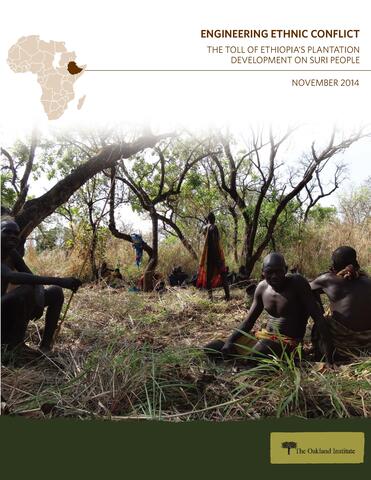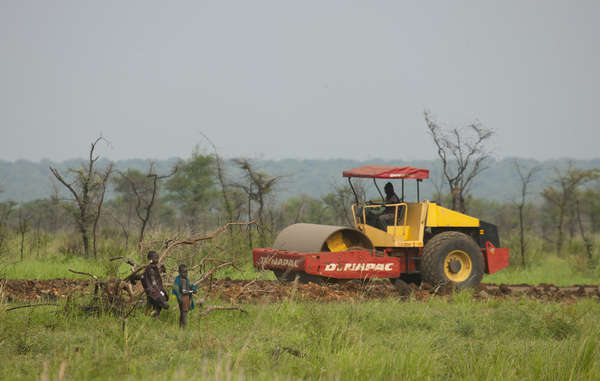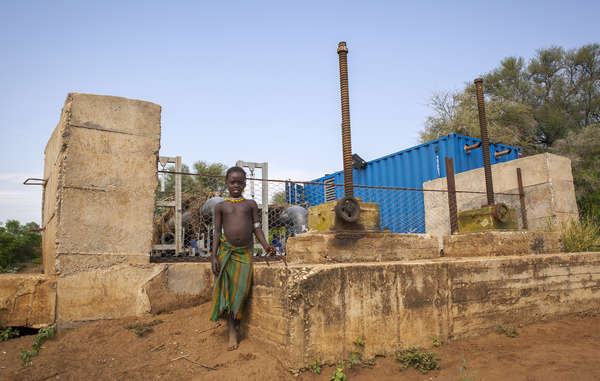(

Ethiopians of the Oromo ethnic group stage a protest against the ruling government. (Reuters/Darrin Zammit Lupi)
By Hilary Matfess and Foreign Policy In Focus)
September 12, 2014, Nairobi, Kenya (The Daily Nations) — Yehun and Miriam have little hope for the future.
“We didn’t do anything and they destroyed our house,” Miriam told me. “We are appealing to the mayor, but there have been no answers. The government does not know where we live now, so it is not possible for them to compensate us even if they wanted.”
Like the other residents of Legetafo—a small, rural town about twenty kilometers from Addis Ababa—Yehun and Miriam are subsistence farmers. Or rather, they were, before government bulldozers demolished their home and the authorities confiscated their land. The government demolished fifteen houses in Legetafo in July.
The farmers in the community stood in the streets, attempting to prevent the demolitions, but the protests were met with swift and harsh government repression. Many other Oromo families on the outskirts of Ethiopia’s bustling capital are now wondering whether their communities could be next.
These homes were demolished in order to implement what’s being called Ethiopia’s “Integrated Master Plan.” The IMP has been heralded by its advocates as a bold modernization plan for the “Capital of Africa.”
The plan intends to integrate Addis Ababa with the surrounding towns in Oromia, one of the largest states in Ethiopia and home to the Oromo ethnic group—which, with about a third of the country’s population, is its largest single ethnic community. While the plan’s proponents consider the territorial expansion of the capital to be another example of what US Secretary of State John Kerry has called the country’s “terrific efforts” toward development, others argue that the plan favors a narrow group of ethnic elites while repressing the citizens of Oromia.
“At least two people were shot and injured,” according to Miriam, a 28-year-old Legetafo farmer whose home was demolished that day. “The situation is very upsetting. We asked to get our property before the demolition, but they refused. Some people were shot. Many were beaten and arrested. My husband was beaten repeatedly with a stick by the police while in jail.”
Yehun, a 20-year-old farmer from the town, said the community was given no warning about the demolitions. “I didn’t even have time to change my clothes,” he said sheepishly. Yehun and his family walked twenty kilometers barefoot to Sendafa, where his extended family could take them in.
The Price of Resistance
Opponents of the plan have been met with fierce repression.
“The Integrated Master Plan is a threat to Oromia as a nation and as a people,” Fasil stated, leaning forward in a scuffed hotel armchair. Reading from notes scribbled on a sheet of loose-leaf notebook paper, the hardened student activist continued: “The plan would take away territory from Oromia,” depriving the region of tax revenue and political representation, “and is a cultural threat to the Oromo people living there.”
A small scar above his eye, deafness in one ear and a lingering gastrointestinal disease picked up in prison testify to Fasil’s commitment to the cause. His injuries come courtesy of the
police brutality he encountered during the four-year prison sentence he served after he was arrested for protesting for Oromo rights in high school and, more recently, against the IMP at Addis Ababa University.
Fasil is just one of the estimated thousands of students who were detained during university protests against the IMP. Though Fasil was beaten, electrocuted and harassed while he was imprisoned last May, he considers himself lucky. “We know that sixty-two students were killed and 125 are still missing,” he confided in a low voice.
The students ground their protests in Ethiopia’s federal Constitution. “We are merely asking that the government abide by the Constitution,” Fasil explained, arguing that the plan violates at least eight constitutional provisions. In particular, the students claim that the plan violates Article 49(5), which protects “the special interest of the State of Oromia in Addis Ababa” and gives the district the right to resist federal incursions into “administrative matters.”
Moreover, the plan presents a tangible threat to the people living in Oromia. Fasil and other student protesters claimed that the IMP “would allow the city to expand to a size that would completely cut off West Oromia from East Oromia.” When the plan is fully implemented, an estimated 2 million farmers will be displaced. “These farmers will have no other opportunities,” Fasil told me. “We have seen this before when the city grew. When they lose their land, the farmers will become day laborers or beggars.”
Winners and Losers
The controversy highlights the disruptive and often violent processes that can accompany economic growth. “What is development, after all?” Fasil asked me.
Ethiopia’s growth statistics are some of the most impressive in the region. Backed by aid from the US government, the Ethiopian People’s Revolutionary Democratic Front (EPRDF), the country’s ruling coalition, is committed to modernizing agricultural production and upgrading the country’s economy. Yet there is a lack of consensus about which processes should be considered developmental.
Oromo activists allege that their community has borne a disproportionate share of the costs of development. Advocates like Fasil argue that the “development” programs of the EPRDF are simply a means of marginalizing the Oromo people to consolidate political power within the ruling coalition.
“Ethiopia has a federalism based on identity and language,” explained an Ethiopian political science professor who works on human rights. Nine distinct regions are divided along ethnic lines and are theoretically granted significant autonomy from the central government under the 1994 Constitution. In practice, however, the regions are highly dependent on the central government for revenue transfers and food security, development and health programs. Since the inception of Ethiopia’s ethno-regional federalism, the Oromo have been resistant to incorporation in the broader Ethiopian state and suspicious of the intentions of the Tigray ethnic group, which dominates the EPRDF.
As the 2015 elections approach, the Integrated Master Plan may provide a significant source of political mobilization. “The IMP is part of a broader conflict in Ethiopia over identity, power and political freedoms,” said the professor, who requested anonymity.
American Support
Standing in Gullele Botanic Park in May, Secretary of State Kerry was effusive about the partnership between the United States and Ethiopia, praising the Ethiopian government’s “terrific support in efforts not just with our development challenges and the challenges of Ethiopia itself, but also…the challenges of leadership on the continent and beyond.”
Kerry’s rhetoric is matched by a significant amount of US financial support. In 2013, Washington allocated more than $619 million in foreign assistance to Ethiopia, making it one of the largest recipients of US aid on the continent.
According to USAID, Ethiopia is “the linchpin to stability in the Horn of Africa and the Global War on Terrorism.”
Kerry asserted that “the United States could be a vital catalyst in this continent’s continued transformation.” Yet if “transformation” entails land seizures, home demolitions and political repression, then it’s worth questioning just what kind of development American taxpayers are subsidizing.
The American people must wrestle with the implications of “development assistance” programs and the thin line between modernization and marginalization in countries like Ethiopia. Though the US government has occasionally expressed concern about the oppressive tendencies of the Ethiopian regime, few demands for reform have accompanied aid.
For the EPRDF, the process of expanding Addis Ababa is integral to the modernization of Ethiopia and the opportunities inherent to development. For the Oromo people, the Integrated Master Plan is a political and cultural threat. For the residents of Legetafo, the demolition of their homes demonstrates the uncertainty of life in a rapidly changing country.




